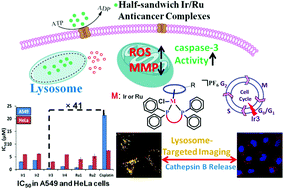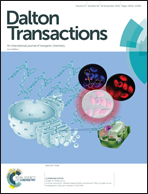Highly potent half-sandwich iridium and ruthenium complexes as lysosome-targeted imaging and anticancer agents†
Abstract
In this study, six half-sandwich luminescent iridium (Ir) and ruthenium (Ru) anticancer complexes bearing P^P-chelating ligands 1,2-bis(diphenylphosphino)benzene (dppbz) and 1,8-bis(diphenylphosphino)naphthalene (dppn) were synthesized and characterized via1H-NMR spectroscopy, 31P-NMR spectroscopy, mass spectrometry, elemental analysis and X-ray crystallography. All the complexes displayed more potent anticancer activity than cisplatin towards A549 lung cancer cells and HeLa cervical cancer cells, especially the most potent iridium complex Ir3, which was 73 times more potent than cisplatin against A549 cells. Different from cisplatin, no nucleobase adducts of Ir3 were detected. With the help of the self-luminescence of complex Ir3 and confocal microscopy, it was observed that Ir3 efficiently penetrated into the A549 cells via energy-dependent active transport, and specifically accumulated in lysosomes, affected the permeabilization of the lysosomal membranes and induced caspase-dependent cell death through lysosomal damage. Both apoptosis and autophagy of the A549 cells were observed. The reactive oxygen species (ROS) elevation, reduction of the mitochondrial membrane potential and cell cycle arrest at the G0/G1 phase also contributed to the observed cytotoxicity of Ir3. We demonstrate that these half-sandwich Ir and Ru anticancer complexes have different anticancer mechanism of action from that of cisplatin, which can be developed as potential multifunctional theranostic platforms that combine bioimaging and anticancer capabilities.



 Please wait while we load your content...
Please wait while we load your content...